African Grey Parrot
Psittacus erithacus
When a grey parrot named Yosuke got lost, it was reunited with its owner after giving the owner's name and address.
Advertisement
African Grey Parrot Scientific Classification
- Kingdom
- Animalia
- Phylum
- Chordata
- Class
- Aves
- Order
- Psittaciformes
- Family
- Psittacidae
- Genus
- Psittacus
- Scientific Name
- Psittacus erithacus
Read our Complete Guide to Classification of Animals.
African Grey Parrot Conservation Status
African Grey Parrot Facts
- Fun Fact
- When a grey parrot named Yosuke got lost, it was reunited with its owner after giving the owner's name and address.
- Estimated Population Size
- 630,00 to 13 million
- Biggest Threat
- Habitat destruction, pet trade, pesticides, hunting
- Other Name(s)
- Congo grey parrot, grey parrot, Congo African grey parrot
- Wingspan
- 18 to 20.5 inches
- Incubation Period
- 30 days
- Litter Size
- three to five
- Habitat
- Lowland forests, mangroves, savannas, gardens
- Predators
- Birds of prey, monkeys, terrestrial predators
- Diet
- Herbivore
- Type
- bird
- Common Name
- African grey parrot
- Number Of Species
- 1
- Location
- Central and West Africa
- Average Clutch Size
- 4
- Nesting Location
- Tree cavity
- Age of Molting
- 12 weeks
View all of the African Grey Parrot images!
“The African grey parrot is the largest parrot in Africa.”
Of all the talking parrots, the African grey parrot is one of the most amazing. Its intelligence is such that it not only talks but understands what it’s hearing and what it’s saying back. Unfortunately, this parrot is in such demand as a pet that it is endangered in the wild.
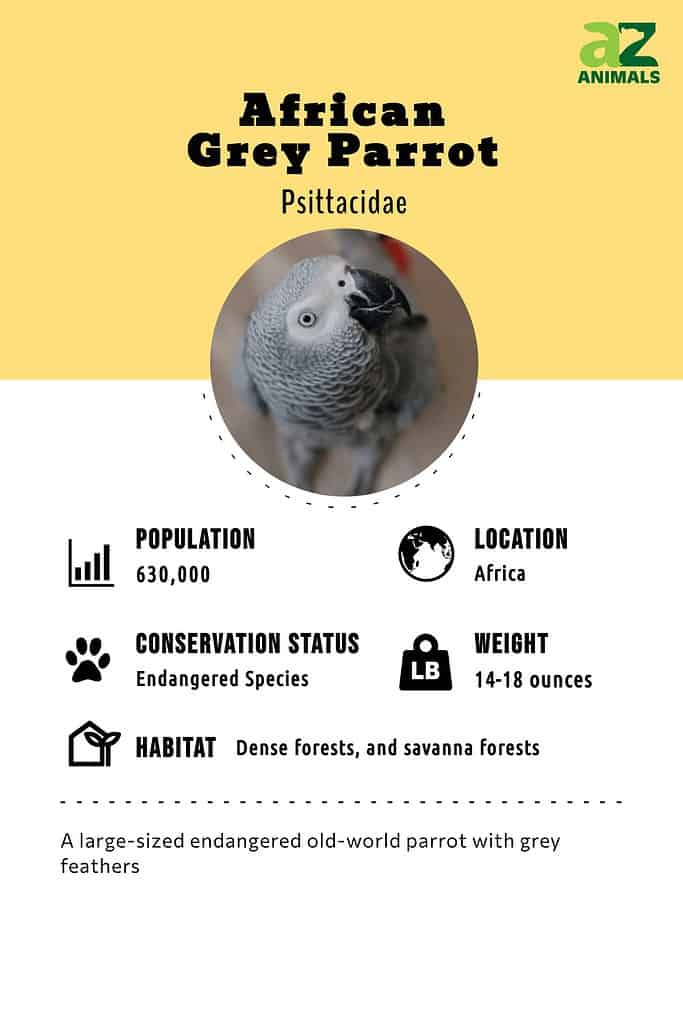
Five Incredible Facts!
Here are five facts about the fabulous African grey parrot:
- This parrot is the second most sought-after parrot to have as a pet, and the price reflects that. The price of an African grey ranges from $1,500 to $3,500, and maintenance costs add up to about $3,200 a year.
- An estimated 21 percent of African grey parrots are collected for the pet trade every year, and 60 to 66 percent do not live to become someone’s pet. This is one reason why the bird’s conservation status is endangered.
- Biologists believed that the Timneh parrot was a subspecies of the African grey parrot, but it’s now considered its own species. Like the grey, the Timneh is a popular pet.
- Pet grey parrots have their favorite music. When their favorite song comes on, they dance and sing along to it.
- Right-footed parrots seem to know and use more words than left-footed parrots
Habitat: Where To Find Them

Humans are by far the biggest threat to the survival of the Grey Parrot.
©avers/Shutterstock.com
The African grey parrot is native to western and central Africa, in countries such as Uganda, Gabon, Ghana, Ivory Coast, and Cameroon. It’s also found on the island of Principe. The bird is most often found in moist forests of the lowlands, though they can also be found as high up as 7,218 feet. Grey parrots are also seen in gardens, yards, savannas, mangrove forests, and forest clearings. They like to live close to the water and are happiest in trees found on islands in rivers.
Nests
African grey parrots nest in tree cavities. Some of these cavities were once home to other birds, and if the hole is a bit too small, the parrot will use its powerful beak to enlarge it. Each parrot pair has its tree. Pet parrots use a nesting box that’s installed in a high area of their enclosure. This mimics, somewhat, the height of a tree.
Scientific Name

The African Grey Parrot can learn around 1,000 words.
©iStock.com/Adrian Black
The African grey parrot’s scientific name is Psittacus erithacus. Psittacus is simply Latin for “parrot.” Erithacus is an ancient Greek word and seems to refer to a bird such as the European robin. While Erithacus is the epithet for the African grey parrot, it is the genus name for the European robin, Erithacus rubecula. There is now only one species of P. erithacus.
Evolution
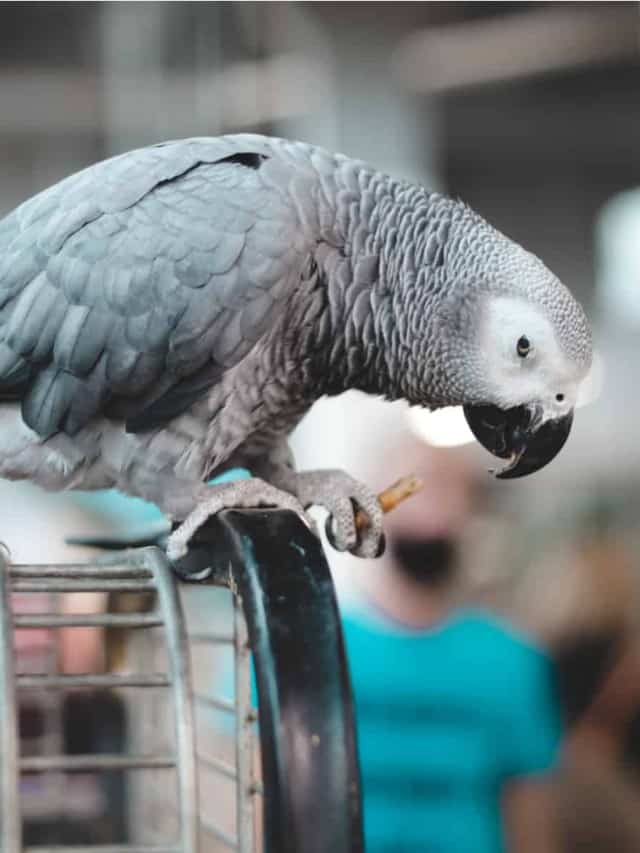
The exact evolution of grey parrots is unknown.
©Jane_Zh/Shutterstock.com
Paleontologists have discovered the fossilized bones of parrots that were dwelling in the moist forests of Europe twenty million years ago. This may seem quite recent in the timeline of birds, which is believed to have begun in the Mesozoic Era, somewhere between 250 and 65 million years ago. This era saw the evolution of birds from small dinosaurs that had feathers and beaks. The majority of the huge dinosaurs perished in a sudden shift of climate due to a massive asteroid collision with Earth and some volcanic eruptions around 65 million years ago. Only the small avian dinosaurs survived this mass extinction event.
Evidence of physical similarities between avian dinosaurs and modern birds has been gathered by scientists. Paleontologists noted that tracks discovered 110 million years ago were comparable to those of modern birds. Additionally, a graduate student found two types of feathers in a piece of 80 million-year-old amber. Despite this evidence, nobody has been able to definitively explain how the avian dinosaurs developed the ability to fly.
Appearance
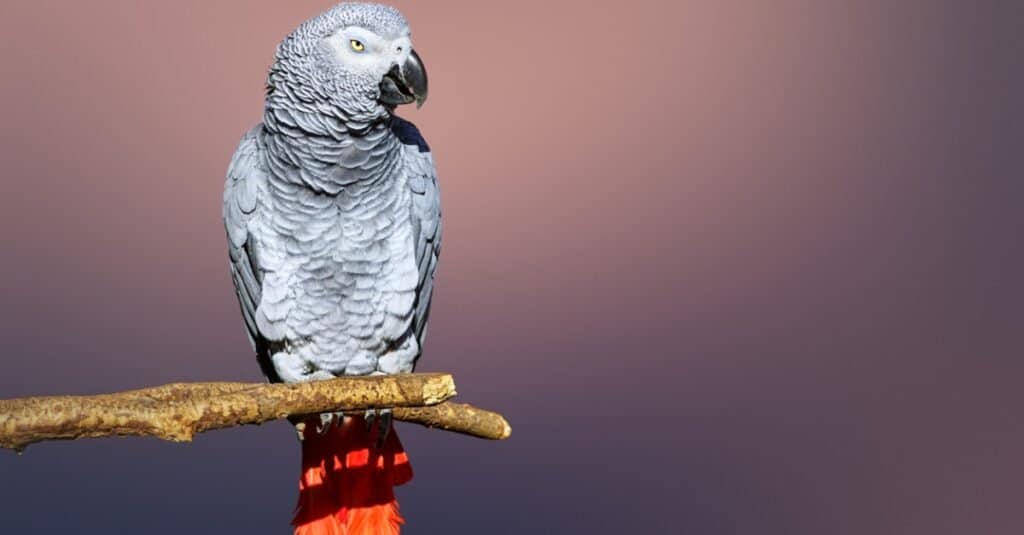
©iStock.com/Etienne Outram
The appearance of the African grey parrot is unmistakable. It is medium-sized for a parrot, and the colors of its feathers are mostly shades of gray, though it has a startling red tail. Some of the feathers have a white edge that makes the bird’s plumage especially elegant. The colors of adults and juveniles are a bit different. Adult birds have yellow irises, while the irises of chicks are dark, and their tails are grayer. The parrot grows to around 13 inches long, has an 18 to 20.5-inch wingspan, and weighs between 14.75 and 18.5 ounces.
Behavior
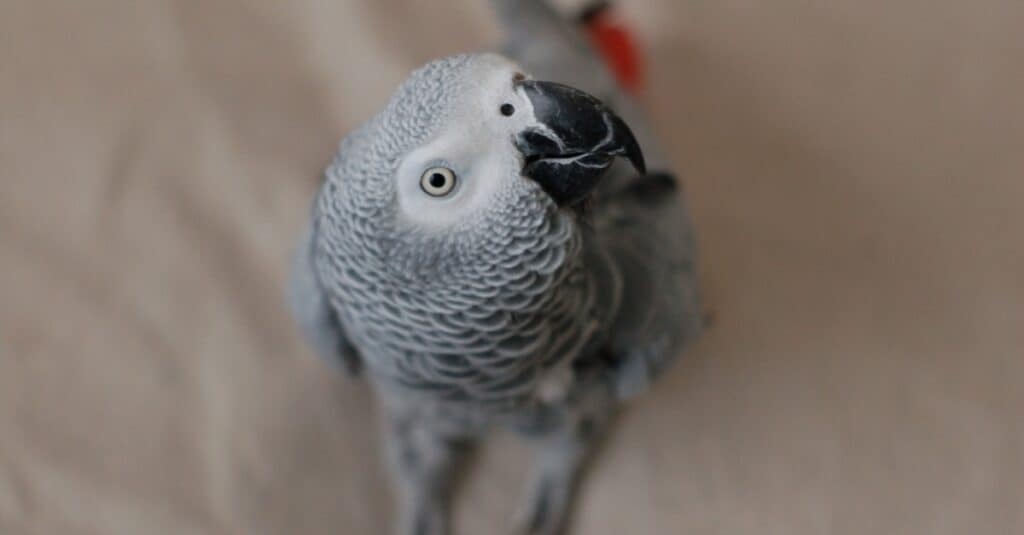
African grey parrots are sentient beings of high-intelligence.
©iStock.com/Lilly Nonamaker
African grey parrots are very gregarious birds, which is why they are rather high-maintenance pets. Their intelligence demands mental stimulation, either from their owner or, ideally, another grey parrot or two. Though they are difficult to study in the wild, even wild birds are excellent mimics of other birds.
Though each parrot family has its tree to nest in, they congregate in huge flocks to roost in trees. Unlike other parrots, their flocks do not contain other species of parrots.
They are quiet during the night. Then at dawn, they use vocalizations to warn of danger, beg for food, and identify each other. It might sound like a lot of screaming to humans, but the vocalizations are complex and have to be learned by juveniles.
Because they need to learn a great deal about how to be a grey parrot, juveniles can stay with their families for years. During these years, grey parrots need to learn how to find food and water, how to defend their territory, and how to identify potential predators and avoid them. They also need to learn how to establish and defend their nesting sites and raise chicks. This leads to grey parrots becoming quite aggressive with each other when it comes to finding nest holes. On the other hand, grey parrots can be altruistic and share food with other grey parrots.
Scientists believe that the African grey parrot is not just one of nature’s most intelligent birds but one of nature’s most intelligent animals. They have insight, can perform complex tasks, understand musical theory to some extent and solve complex problems. A famous talking parrot named Alex could categorize, ask for, identify, and refuse dozens of objects. He not only mimicked human speech but clearly understood it. He died in 2007, at the age of only 31, of an apparent heart attack.
Migration Pattern and Timing
African grey parrots don’t exactly migrate. During the dry season, they move in flocks from the driest areas to places where there’s more water and food.
African Grey Parrots do not undertake long-distance migration like other bird species. But, they can travel many miles from their home range in search of new food sources during certain times of the year. During periods when food is scarce or seasonal changes cause an imbalance in their natural habitat, African Greys will migrate short distances within their range to find a better environment with more resources. These birds also sometimes move around between different breeding locations throughout the course of their lives as well as disperse young individuals across larger areas in order to establish new populations.
Diet
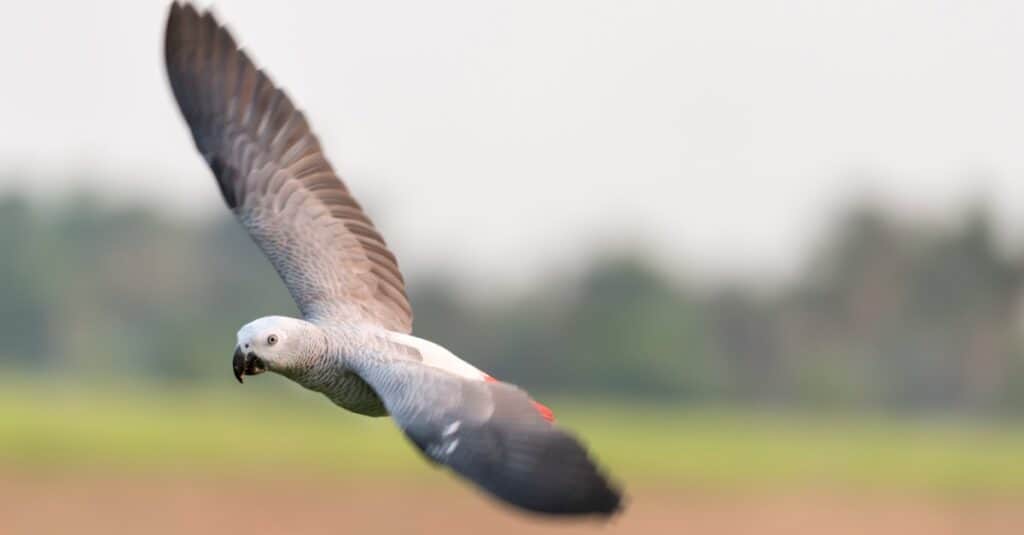
African grey parrots prefer fruit as their main food source.
©Watchara Manusnanta/Shutterstock.com
These parrots are herbivores and eat mostly fruit and nuts. They’ll also eat leaves and bark and will take snails and insects now and then. They’re partial to the fruit of the oil palm. African gray parrots mostly forage on the ground, and flocks of birds do this with care and foresight. First, they’ll gather in a tree, and they’ll descend to the ground in waves to find food. This keeps all the birds from being on the ground and thus subject to terrestrial predators at the same time. The parrots also ingest soil, which absorbs some of the toxins in their food.
If they do eat in a tree, the parrot climbs, not flies, from branch to branch.
Pet parrot maintenance includes a well-balanced diet made up of some seeds, nuts, fruits, and vegetables, including leafy greens. Parrots shouldn’t be fed avocados because they are toxic and must always have fresh water available. Ideally, pellets formulated for African gray parrots should be a major part of their diet.
Predators and Threats
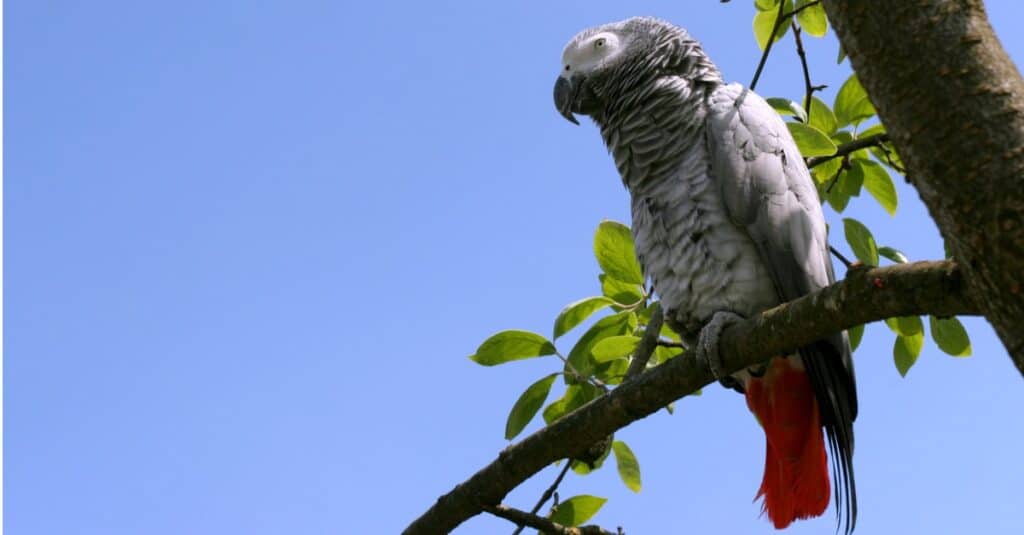
African grey parrots have to watch out for Palm Nut Vultures.
©iStock.com/AJevs
This talking parrot finds safety in numbers in the wild, but it does have predators and threats. The worst of these predators is humans. Humans destroy the birds’ habitat, hunt them for traditional medicine and food and collect them for the pet trade, even though most birds die before they find a loving home.
One major natural predator of the parrot is the palm nut vulture, a small Old World vulture with striking black and white plumage. It is one of a few birds of prey that take grey parrots. Monkeys also steal parrot eggs and chicks, as do tree-climbing snakes. One way that parrots deter predators is to go silent when they see one, then all of a sudden erupt from the trees, screaming. This is sometimes enough to spook a predator.
Besides predators, parrots are subject to a variety of diseases, including blood parasites and tapeworms. Young parrots can succumb to a virus that causes psittacine beak and feather disease. In captivity, parrots can be stricken with infections and cancers. Obesity and malnutrition are also risks if the parrot doesn’t receive excellent care.
Reproduction, Babies, and Lifespan

Baby Grey Parrots stay with their mother for several years.
©iStock.com/surachetsh
The reproductive strategies of the grey parrot haven’t been studied extensively, but scientists do know that they mate for life after a courtship dance where they both droop their wings. The birds breed one or two times a year.
The female lays from three to five eggs in the tree cavity and incubates them while the male feeds her from the outside. The eggs, which are laid at two to five-day intervals, hatch after 30 days. Both parents take care of the babies, who are born blind and helpless. African grey parrot chicks take a long time to reach independence for a bird, even though they fledge when they’re about 12 weeks old. It can be three years before they have learned enough to be independent and another two years before they are reproductively mature. The lifespan of a wild parrot is about 23 years on average, while they can live 60 years or more in captivity.
Conservation and Population
The population of African gray parrots is estimated to be between 630,000 to 13 million, but the bird is under pressure because of habitat destruction and collection for the pet trade.
African grey parrots are currently listed as Endangered on the IUCN Red List, and their population has been decreasing rapidly over the past few decades. The primary cause of this decline is mainly due to deforestation, which reduces suitable habitat for these parrots. Additionally, they have also been heavily affected by illegal trapping and smuggling for the pet trade industry. They are also at risk from being hunted for meat in some parts of Africa, although this does not appear to be a major factor in overall declines in African gray parrot populations. Conservation efforts such as habitat protection, law enforcement against poaching and smuggling, and education initiatives to raise awareness about conservation issues related to African gray parrots should all be implemented to help protect them from further decline.
View all 194 animals that start with AAfrican Grey Parrot FAQs (Frequently Asked Questions)
Are African Grey Parrots carnivores, herbivores, or omnivores?
African grey parrots are herbivores. They eat seeds, nuts, fruits and flowers. Occasionally, they’ll eat a small invertebrate such as an insect or a snail.
Are African grey parrots endangered?
These parrots are endangered in the wild due to the pet trade, hunting, and habitat destruction.
Do African Grey parrots make good pets?
African grey parrots can make excellent pets, but they’re high maintenance. As extremely intelligent animals, they need a great deal of mental and physical exercise to stay happy and healthy. They also need a balanced diet as they tend to become obese. They are also expensive. The price of one parrot can be as high s $3500.
Can an African Grey Parrot talk?
African grey parrots are famous for their ability to talk. This is the reason they are so sought after as pets.
Are African Grey parrots aggressive?
African grey parrots can be quite aggressive toward each other during the breeding season. Each pair nests in a tree hollow, and they have to have their own tree. If there are not enough trees for every pair, things can get unpleasant.
How intelligent is an African Grey Parrot?
Some studies have indicated that an African grey parrot can be as intelligent as a six-year-old human child.
Can African Grey parrots understand English?
Some African grey parrots do seem to have the ability to understand English, or whatever language they were taught.
Thank you for reading! Have some feedback for us? Contact the AZ Animals editorial team.
Sources
- NEWS / Accessed November 13, 2021
- Parrot Website / Accessed November 13, 2021
- ITIS / Accessed November 13, 2021
- Wikipedia / Accessed November 13, 2021
- The Links Road Animal & Bird Clinic / Accessed November 13, 2021
- The New York Times / Accessed November 13, 2021
- VCA / Accessed November 13, 2021
- Rainforest Alliance / Accessed November 13, 2021
- IUCN / Accessed November 13, 2021


















